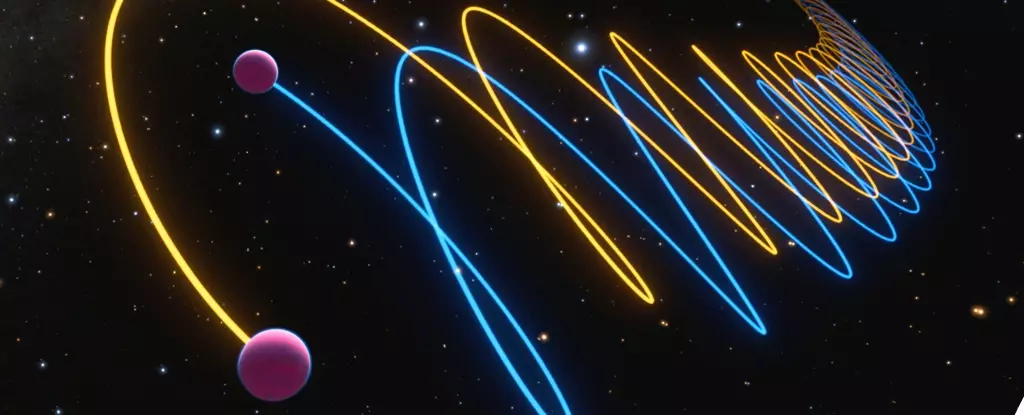In the realm of astronomy, discoveries often lead to more questions than answers. Such is the case with Gliese 229 B, a celestial body orbiting the red dwarf star Gliese 229. First identified in 1995 by a group of Caltech researchers at the Palomar Observatory, this brown dwarf has perplexed astronomers for nearly three decades. Initially believed to be a solitary entity, recent evidence suggests that Gliese 229 B is, in fact, two closely orbiting brown dwarfs. This revelation not only impacts our understanding of this particular object but also adds layers to our broader comprehension of stellar formation and evolution.
The early observations of Gliese 229 B uncovered methane in its atmosphere, a hallmark of gas giants yet not typically associated with stars. This groundbreaking discovery marked a pivotal moment in the field, recognizing Gliese 229 B as the first confirmed brown dwarf—functioning as the theoretical bridge between gas giants and stars. Co-author Rebecca Oppenheimer, a member of the original discovery team, reflected on the excitement of finding an object smaller than a star in orbit around another stellar body. This finding played a significant role in propelling forward a subfield of astronomy dedicated to discovering similar so-called “oddballs.”
For years, Gliese 229 B was revered as the archetypal brown dwarf, yet its dimness posed a perplexing question. With a mass equivalent to 70 times that of Jupiter, Gliese 229 B was expected to emit much more light than observed. This inconsistency drew the attention of astronomers over the years, igniting debates and fueling research aimed at uncovering its true nature.
A recent collaborative study, spearheaded by graduate student Jerry W. Xuan at Caltech, has definitively resolved the longstanding mystery surrounding Gliese 229 B. Utilizing the GRAVITY interferometer employed at the European Southern Observatory’s Very Large Telescope in Chile, the research team was able to spatially resolve the supposed single brown dwarf into two separate entities: Gliese 229 Ba and Gliese 229 Bb. These brown dwarfs possess masses of approximately 38 and 34 times that of Jupiter, respectively, and orbit one another every 12 days, with a separation equivalent to sixteen times the distance from the Earth to the Moon.
By employing advanced technology, including the CRyogenic high-resolution InfraRed Echelle Spectrograph (CRIRES+), researchers were able to differentiate between the spectral signatures of the two brown dwarfs and measure their Doppler shifts. The findings highlighted a significant harmony between the brightness levels of these objects and what was predicted for small brown dwarfs, thereby readying the stage for an enlightened understanding of such celestial formations.
The implications of this discovery extend far beyond just a revised classification of Gliese 229 B. It prompts intriguing questions about the formation processes of brown dwarfs. Astrophysicists speculate that these pairs may arise from a protoplanetary disk, in which instances of fragmentation could lead to the creation of gravitationally bound brown dwarf binaries. Understanding these dynamics could also provide insights into the formation of similarly orbiting exoplanet pairs, thus opening new avenues for future research.
As senior research scientist Dimitri Mawet commendably stated, this revelation “resolves the recent tension observed between mass and luminosity” for Gliese 229 B, significantly enhancing our foundational knowledge about brown dwarfs and their elusive characteristics.
Looking ahead, the research team is poised to continue their exploration into the world of brown dwarf binaries. Utilizing cutting-edge instruments such as the Keck Planet Imager and Characterizer (KPIC), as well as the forthcoming High-resolution Infrared Spectrograph for Exoplanet Characterization (HISPEC), researchers aim to widen their net and uncover more similar celestial pairings. The continuous evolution of telescope technology promises to unlock further mysteries within our universe, enhancing our understanding of brown dwarfs and their dynamics.
The unraveling mystery of Gliese 229 encapsulates the spirit of scientific inquiry—every answer reveals new questions, driving astronomers to look deeper into the cosmos. As our capacity to observe and analyze advances, we edge closer to comprehending the intricate tapestry of stellar evolution, with Gliese 229 B as a significant thread in this ever-complex narrative.

